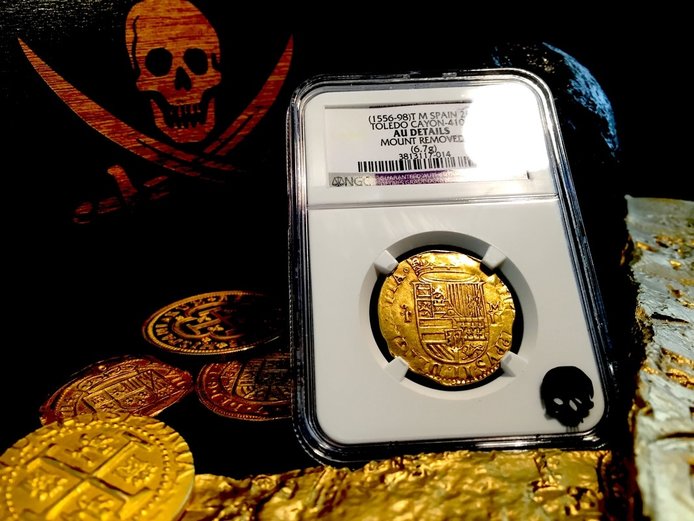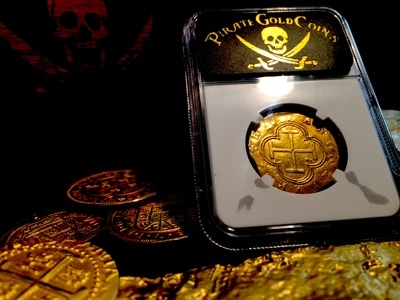Spain 2 Escudos 1556-98 "Toledo Mint" NGC AU DETS Huge Planchet!
SPAIN 1556-98 2 ESCUDOS NGC AU DETAILS KING PHILIP II- TOLEDO MINT "VERY ROUND & LUSTEROUS!" I would have to say this must be in the top three if not, "the" FINEST PIECE we've had in regards to having a Large Planchet and Roundness for full Legends!!! Also, very atypical, to have so much of the CROWN centered on the Planchett – even more unusual on a 2 Escudos is that the Crown is centered "AND" the bottom of the coin is not cut off, clearly (actually the clearest I've ever seen) the DEI GRATIA and Philippvs are still in tact in the legend as well. Truly unheard of!!! DEI GRATIA of course means (by the Grace of GOD). Truly an immaculate piece that is seriously under graded. Regardless of grade, this is truly a Trophy Piece for the issue!
Philip II of Spain (Spanish: Felipe II; 21 May 1527 – 13 September 1598) was King of Spain (as Philip II in Castille and Philip I in Aragon) and Portugal as Philip I (Portuguese: Filipe I). During his marriage to Queen Mary I, he was King of England and Ireland and pretender to the kingdom of France. As heir to the Duchy of Burgundy, he was lord of the Seventeen Provinces of the Netherlands. Known in Spanish as "Philip the Prudent" (Felipe el Prudente), his empire included territories in every continent then known to Europeans and during his reign Spain was the foremost Western European power. Under his rule, Spain reached the height of its influence and power, directing explorations all around the world and settling the colonisation of territories in all the known continents including his namesake Philippine islands. However, he was also responsible for four separate state bankruptcies in 1557, 1560, 1575, and 1596; precipitating the declaration of independence which created the Dutch Republic in 1581; and the disastrous fate of the 1588 invasion of England. Philip was born in Valladolid, the son of Charles V, Holy Roman Emperor and King of Spain, and his consort, Isabella of Portugal. He was described by the Venetian ambassador Paolo Fagolo in 1563 as "slight of stature and round-faced, with pale blue eyes, somewhat prominent lip, and pink skin, but his overall appearance is very attractive." The Ambassador went on to say "He dresses very tastefully, and everything that he does is courteous and gracious."
Philip II of Spain (Spanish: Felipe II; 21 May 1527 – 13 September 1598) was King of Spain (as Philip II in Castille and Philip I in Aragon) and Portugal as Philip I (Portuguese: Filipe I). During his marriage to Queen Mary I, he was King of England and Ireland and pretender to the kingdom of France. As heir to the Duchy of Burgundy, he was lord of the Seventeen Provinces of the Netherlands. Known in Spanish as "Philip the Prudent" (Felipe el Prudente), his empire included territories in every continent then known to Europeans and during his reign Spain was the foremost Western European power. Under his rule, Spain reached the height of its influence and power, directing explorations all around the world and settling the colonisation of territories in all the known continents including his namesake Philippine islands. However, he was also responsible for four separate state bankruptcies in 1557, 1560, 1575, and 1596; precipitating the declaration of independence which created the Dutch Republic in 1581; and the disastrous fate of the 1588 invasion of England. Philip was born in Valladolid, the son of Charles V, Holy Roman Emperor and King of Spain, and his consort, Isabella of Portugal. He was described by the Venetian ambassador Paolo Fagolo in 1563 as "slight of stature and round-faced, with pale blue eyes, somewhat prominent lip, and pink skin, but his overall appearance is very attractive." The Ambassador went on to say "He dresses very tastefully, and everything that he does is courteous and gracious."









